Expert Performance in Action Anticipation: Visual Search Behavior in Volleyball Spiking Defense from Different Viewing Perspectives
Abstract
1. Introduction
2. Materials and Methods
2.1. Participants
2.2. Experimental Materials
2.2.1. Experiment Equipment
2.2.2. Video Production
2.2.3. Video Clipping
2.3. Experimental Design and Process
2.4. Areas of Interest
2.5. Statistical Analyses
3. Results
3.1. Behavioral Data
3.2. Whole Fixation Data
3.2.1. Total Fixation Duration of Each Video
3.2.2. Number of Fixations
3.2.3. First Fixation Duration
3.3. Fixation Proportion of Areas of Interest
3.3.1. Pre-Spike Phase
3.3.2. Spiking Phase
4. Discussion
4.1. Superior Response Accuracy but Similar Response Times
4.2. Whole Fixation Variables
4.3. Areas of Interest from Different Perspectives
4.4. Limitations, Strengths, and Future Studies
5. Conclusions
Supplementary Materials
Author Contributions
Funding
Institutional Review Board Statement
Informed Consent Statement
Data Availability Statement
Acknowledgments
Conflicts of Interest
References
- Sheppard, J.M.; Gabbett, T.J.; Stanganelli, L.-C.R. An Analysis of Playing Positions in Elite Men’s Volleyball: Considerations for Competition Demands and Physiologic Characteristics. J. Strength Cond. Res. 2009, 23, 1858–1866. [Google Scholar] [CrossRef]
- Abernethy, B. Expertise, Visual Search, and Information Pick-up in Squash. Perception 1990, 19, 63–77. [Google Scholar] [CrossRef]
- Savelsbergh, G.; Williams, A.; Van der Kamp, J.; Ward, P. Visual Search, Anticipation and Expertise in Soccer Goalkeepers. J. Sports Sci. 2002, 20, 279–287. [Google Scholar] [CrossRef]
- Mann, D.; Williams, A.; Ward, P.; Janelle, C. Perceptual-Cognitive Expertise in Sport: A Meta-Analysis. J. Sport Exerc. Psychol. 2007, 29, 457–478. [Google Scholar] [CrossRef]
- Williams, A.M.; Davids, K.; Williams, J.G.P. Visual Perception and Action in Sport; E & FN Spon [u.a.]: London, UK, 2000; ISBN 978-0-419-18290-0. [Google Scholar]
- Del Villar, F.; González, L.; Iglesias, D.; Moreno, M.; Cervelló, E. Expert-Novice Differences in Cognitive and Execution Skills during Tennis Competition. Percept. Mot. Skills 2007, 104, 355–365. [Google Scholar] [CrossRef]
- Abernethy, B.; Gill, D.P.; Parks, S.L.; Packer, S.T. Expertise and the Perception of Kinematic and Situational Probability Information. Perception 2001, 30, 233–252. [Google Scholar] [CrossRef]
- Aglioti, S.; Cesari, P.; Romani, M.; Urgesi, C. Action Anticipation and Motor Resonance in Elite Basketball Players. Nat. Neurosci. 2008, 11, 1109–1116. [Google Scholar] [CrossRef]
- Yarrow, K.; Brown, P.; Krakauer, J.W. Inside the Brain of an Elite Athlete: The Neural Processes That Support High Achievement in Sports. Nat. Rev. Neurosci. 2009, 10, 585–596. [Google Scholar] [CrossRef]
- Schläppi-Lienhard, O.; Hossner, E.-J. Decision Making in Beach Volleyball Defense: Crucial Factors Derived from Interviews with Top-Level Experts. Psychol. Sport Exerc. 2015, 16, 60–73. [Google Scholar] [CrossRef]
- Afonso, J.; Garganta, J.; Mcrobert, A.; Williams, A.M.; Mesquita, I. The Perceptual Cognitive Processes Underpinning Skilled Performance in Volleyball: Evidence from Eye-Movements and Verbal Reports of Thinking Involving an in Situ Representative Task. J. Sports Sci. Med. 2012, 11, 339–345. [Google Scholar]
- Kredel, R.; Vater, C.; Klostermann, A.; Hossner, E.-J. Eye-Tracking Technology and the Dynamics of Natural Gaze Behavior in Sports: A Systematic Review of 40 Years of Research. Front. Psychol. 2017, 8, 1845. [Google Scholar] [CrossRef]
- Vickers, J.N. Perception, Cognition, and Decision Training: The Quiet Eye in Action; Human Kinetics: Champaign, IL, USA, 2007. [Google Scholar]
- Vila-Maldonado, S.; Saez-Gallego, N.M.; Garcia-Lopez, L.M.; Contreras, O.R. Influence of Visual Behaviour on Decision Making in Volleyball Blocking. Rev. Int. Med. Cienc. Act. Fis. Deporte 2019, 19, 489–504. [Google Scholar] [CrossRef]
- Just, M.A.; Carpenter, P.A. The Role of Eye-Fixation Research in Cognitive Psychology. Behav. Res. Methods Instrum. 1976, 8, 139–143. [Google Scholar] [CrossRef]
- Farrow, D.; Abernethy, B.; Jackson, R.C. Probing Expert Anticipation With the Temporal Occlusion Paradigm: Experimental Investigations of Some Methodological Issues. Motor Control 2005, 9, 332–351. [Google Scholar] [CrossRef]
- Farrow, D.; Abernethy, B. Can Anticipatory Skills Be Learned through Implicit Video-Based Perceptual Training? J. Sports Sci. 2002, 20, 471–485. [Google Scholar] [CrossRef]
- Hinz, M.; Lehmann, N.; Aye, N.; Melcher, K.; Tolentino-Castro, J.W.; Wagner, H.; Taubert, M. Differences in Decision-Making Behavior Between Elite and Amateur Team-Handball Players in a Near-Game Test Situation. Front. Psychol. 2022, 13, 854208. [Google Scholar] [CrossRef]
- Goulet, C.; Bard, C.; Fleury, M. Expertise Differences in Preparing to Return a Tennis Serve: A Visual Information Processing Approach. J. Sport Exerc. Psychol. 1989, 11, 382–398. [Google Scholar] [CrossRef]
- Rowe, R.M.; McKenna, F.P. Skilled Anticipation in Real-World Tasks: Measurement of Attentional Demands in the Domain of Tennis. J. Exp. Psychol. Appl. 2001, 7, 60–67. [Google Scholar] [CrossRef]
- Lin, Y.-N.; Wang, J.; Su, Y.; Wang, I.-L. Exploring the Gaze Behavior of Tennis Players with Different Skill Levels When Receiving Serves through Eye Movement Information. Appl. Sci. 2021, 11, 8794. [Google Scholar] [CrossRef]
- Abernethy, B.; Russell, D.G. Expert-Novice Differences in an Applied Selective Attention Task. J. Sport Exerc. Psychol. 1987, 9, 326–345. [Google Scholar] [CrossRef]
- Xu, H.; Wang, P.; Ye, Z.; Di, X.; Xu, G.; Mo, L.; Lin, H.; Rao, H.; Jin, H. The Role of Medial Frontal Cortex in Action Anticipation in Professional Badminton Players. Front. Psychol. 2016, 7, 1817. [Google Scholar] [CrossRef]
- Williams, A.M.; Davids, K.; Burwitz, L.; Williams, J.G. Visual Search Strategies in Experienced and Inexperienced Soccer Players. Res. Q. Exerc. Sport 1994, 65, 127–135. [Google Scholar] [CrossRef]
- Wang, X.; Liu, Z.; Zhang, H.; Ji, C. Transfer Effect of Cognitive Advantages in Visual Working Memory Capacity: Evidence from Elite Football Players. Behav. Sci. 2023, 13, 464. [Google Scholar] [CrossRef]
- Nicolosi, S.; Quinto, A.; Lipoma, M.; Sgrò, F. Situational Analysis and Tactical Decision-Making in Elite Handball Players. Appl. Sci. 2023, 13, 8920. [Google Scholar] [CrossRef]
- Williams, A.; Ward, P.; Knowles, J.; Smeeton, N. Anticipation Skill in a Real-World Task: Measurement, Training, and Transfer in Tennis. J. Exp. Psychol. Appl. 2002, 8, 259–270. [Google Scholar] [CrossRef]
- Gegenfurtner, A.; Lehtinen, E.; Säljö, R. Expertise Differences in the Comprehension of Visualizations: A Meta-Analysis of Eye-Tracking Research in Professional Domains. Educ. Psychol. Rev. 2011, 23, 523–552. [Google Scholar] [CrossRef]
- Vaeyens, R.; Lenoir, M.; Williams, A.M.; Mazyn, L.; Philippaerts, R.M. The Effects of Task Constraints on Visual Search Behavior and Decision-Making Skill in Youth Soccer Players. J. Sport Exerc. Psychol. 2007, 29, 147–169. [Google Scholar] [CrossRef]
- Ward, P.; Williams, A. Perceptual and Cognitive Skill Development in Soccer: The Multidimensional Nature of Expert Performance. J. Sport Exerc. Psychol. 2003, 25, 93–111. [Google Scholar] [CrossRef]
- Travassos, B.; Araújo, D.; Davids, K.; O’Hara, K.; Leitão, J.; Cortinhas, A. Expertise Effects on Decision-Making in Sport Are Constrained by Requisite Response Behaviours—A Meta-Analysis. Psychol. Sport Exerc. 2013, 14, 211–219. [Google Scholar] [CrossRef]
- Ashford, M.; Abraham, A.; Poolton, J. Understanding a Player’s Decision-Making Process in Team Sports: A Systematic Review of Empirical Evidence. Sports 2021, 9, 65. [Google Scholar] [CrossRef]
- Afonso, J.; Garganta, J.; Mcrobert, A.; Williams, M.; Mesquita, I. Visual Search Behaviours and Verbal Reports during Film-Based and in Situ Representative Tasks in Volleyball. Eur. J. Sport Sci. 2014, 14, 177–184. [Google Scholar] [CrossRef]
- Fortin-Guichard, D.; Laflamme, V.; Julien, A.-S.; Trottier, C.; Grondin, S. Decision-Making and Dynamics of Eye Movements in Volleyball Experts. Sci. Rep. 2020, 10, 17288. [Google Scholar] [CrossRef]
- Afonso, J.; Mesquita, I.; Palao, J.M. Relationship between the Use of Commit-Block and the Numbers of Blockers and Block Effectiveness. Int. J. Perform. Anal. Sport 2005, 5, 36–45. [Google Scholar] [CrossRef]
- Eom, H.J.; Schutz, R.W. Statistical Analyses of Volleyball Team Performance. Res. Q. Exerc. Sport 1992, 63, 11–18. [Google Scholar] [CrossRef]
- Palao, J.M.; Santos, J.A.; Ureña, A. Effect of Team Level on Skill Performance in Volleyball. Int. J. Perform. Anal. Sport 2004, 4, 50–60. [Google Scholar] [CrossRef]
- Piras, A.; Lobietti, R.; Squatrito, S. A Study of Saccadic Eye Movement Dynamics in Volleyball: Comparison between Athletes and Non-Athletes. J. Sports Med. Phys. Fitness 2010, 50, 99–108. [Google Scholar] [PubMed]
- Laffer, J.C.; Coutts, A.J.; Fransen, J. Effect of Skill Level on Allocation of Visual Attention in Volleyball Blocking. J. Mot. Learn. Dev. 2019, 7, 215–231. [Google Scholar] [CrossRef]
- Afonso, J.; Mesquita, I. Skill-Based Differences In Visual Search Behaviours And Verbal Reports In A Representative Film-Based Task In Volleyball. Int. J. Perform. Anal. Sport 2013, 13, 669–677. [Google Scholar] [CrossRef]
- Vansteenkiste, P.; Vaeyens, R.; Zeuwts, L.; Philippaerts, R.; Lenoir, M. Cue Usage in Volleyball: A Time Course Comparison of Elite, Intermediate and Novice Female Players. Biol. Sport 2014, 31, 295–302. [Google Scholar] [CrossRef]
- Wang, C.; Yan, A.; Deng, W.; Qi, C. Effect of Tennis Expertise on Motion-in-Depth Perception at Different Speeds: An Event-Related Potential Study. Brain Sci. 2022, 12, 1160. [Google Scholar] [CrossRef]
- Lee, S.M. Does Your Eye Keep on the Ball?: The Strategy of Eye Movement for Volleyball Defensive Players During Spike Serve Reception. Int. J. Appl. Sports Sci. 2010, 22, 128–137. [Google Scholar]
- Piras, A.; Lobietti, R.; Squatrito, S. Response Time, Visual Search Strategy, and Anticipatory Skills in Volleyball Players. J. Ophthalmol. 2014, 189268. [Google Scholar] [CrossRef]
- Loffing, F.; Hagemann, N.; Schorer, J.; Baker, J. Skilled Players’ and Novices’ Difficulty Anticipating Left- vs. Right-Handed Opponents’ Action Intentions Varies across Different Points in Time. Hum. Mov. Sci. 2015, 40, 410–421. [Google Scholar] [CrossRef]
- Paulo, A.; Zaal, F.T.J.M.; Fonseca, S.; Araújo, D. Predicting Volleyball Serve-Reception. Front. Psychol. 2016, 7, 1694. [Google Scholar] [CrossRef]
- Faul, F.; Erdfelder, E.; Buchner, A.; Lang, A.-G. Statistical Power Analyses Using G*Power 3.1: Tests for Correlation and Regression Analyses. Behav. Res. Methods 2009, 41, 1149–1160. [Google Scholar] [CrossRef]
- Swann, C.; Moran, A.; Piggott, D. Defining Elite Athletes: Issues in the Study of Expert Performance in Sport Psychology. Psychol. Sport Exerc. 2015, 16, 3–14. [Google Scholar] [CrossRef]
- Nyström, M.; Niehorster, D.C.; Andersson, R.; Hooge, I. The Tobii Pro Spectrum: A Useful Tool for Studying Microsaccades? Behav. Res. Methods 2021, 53, 335–353. [Google Scholar] [CrossRef]
- Brault, S.; Bideau, B.; Kulpa, R.; Craig, C.M. Detecting Deception in Movement: The Case of the Side- Step in Rugby. PLoS ONE 2012, 7, e37494. [Google Scholar] [CrossRef]
- Meyer, J.; Smeeton, N.J.; Fasold, F.; Schul, K.; Schön, T.; Klatt, S. Shot Deception in Basketball: Gaze and Anticipation Strategy in Defence. Hum. Mov. Sci. 2022, 84, 102975. [Google Scholar] [CrossRef]
- Daly, J.C.; Cohen, J. Statistical Power Analysis for the Behavioral Sciences, Revised Edition. J. Am. Stat. Assoc. 1978, 73, 680. [Google Scholar] [CrossRef]
- Ward, P.; Williams, A.M.; Bennett, S.J. Visual Search and Biological Motion Perception in Tennis. Res. Q. Exerc. Sport 2002, 73, 107–112. [Google Scholar] [CrossRef]
- Williams, A.M.; Davids, K. Visual Search Strategy, Selective Attention, and Expertise in Soccer. Res. Q. Exerc. Sport 1998, 69, 111–128. [Google Scholar] [CrossRef]
- Ripoll, H.; Kerlirzin, Y.; Stein, J.-F.; Reine, B. Analysis of Information Processing, Decision Making, and Visual Strategies in Complex Problem Solving Sport Situations. Hum. Mov. Sci. 1995, 14, 325–349. [Google Scholar] [CrossRef]
- Wright, D.L.; Gomez-Meza, M.; Pleasants, F. Use of Advanced Visual Cue Sources in Volleyball. J. Sport Exerc. Psychol. 1990, 12, 406–414. [Google Scholar] [CrossRef] [PubMed]
- Schorer, J.; Rienhoff, R.; Fischer, L.; Baker, J. Foveal and Peripheral Fields of Vision Influences Perceptual Skill in Anticipating Opponents’ Attacking Position in Volleyball. Appl. Psychophysiol. Biofeedback 2013, 38, 185–192. [Google Scholar] [CrossRef] [PubMed]
- Roca, A.; Ford, P.R.; McRobert, A.P.; Williams, A.M. Perceptual-Cognitive Skills and Their Interaction as a Function of Task Constraints in Soccer. J. Sport Exerc. Psychol. 2013, 35, 144–155. [Google Scholar] [CrossRef]
- Rodriguez-Ruiz, D.; Quiroga, M.E.; Miralles, J.A.; Sarmiento, S.; De Saá, Y.; García-Manso, J.M. Study of the Technical and Tactical Variables Determining Set Win or Loss in Top-Level European Men’s Volleyball. J. Quant. Anal. Sports 2011, 7, 1281. [Google Scholar] [CrossRef]
- Huys, R.; Cañal-Bruland, R.; Hagemann, N.; Beek, P.J.; Smeeton, N.J.; Williams, A.M. Global Information Pickup Underpins Anticipation of Tennis Shot Direction. J. Mot. Behav. 2009, 41, 158–171. [Google Scholar] [CrossRef]
- Williams, A.M. Perceiving the Intentions of Others: How Do Skilled Performers Make Anticipation Judgments? In Progress in Brain Research; Elsevier: Amsterdam, The Netherlands, 2009; Volume 174, pp. 73–83. ISBN 978-0-444-53356-2. [Google Scholar]
- Decouto, B.S.; Smeeton, N.J.; Williams, A.M. Skilled Performers Show Right Parietal Lateralization during Anticipation of Volleyball Attacks. Brain Sci. 2023, 13, 1204. [Google Scholar] [CrossRef]
- Heilmann, F.; Witte, K. Perception and Action under Different Stimulus Presentations: A Review of Eye-Tracking Studies with an Extended View on Possibilities of Virtual Reality. Appl. Sci. 2021, 11, 5546. [Google Scholar] [CrossRef]
- Shimi, A.; Tsestou, V.; Hadjiaros, M.; Neokleous, K.; Avraamides, M. Attentional Skills in Soccer: Evaluating the Involvement of Attention in Executing a Goalkeeping Task in Virtual Reality. Appl. Sci. 2021, 11, 9341. [Google Scholar] [CrossRef]
- Suárez, M.; Serenini, A.; Fernández-Echeverría, C.; Collado-Mateo, D.; Moreno Arroyo, M. The Effect of Decision Training, from a Cognitive Perspective, on Decision-Making in Volleyball: A Systematic Review and Meta-Analysis. Int. J. Environ. Res. Public Health 2020, 17, 3628. [Google Scholar] [CrossRef] [PubMed]
- Krauzlis, R.J. Chapter 32—Eye Movements. In Fundamental Neuroscience, 4th ed.; Squire, L.R., Berg, D., Bloom, F.E., du Lac, S., Ghosh, A., Spitzer, N.C., Eds.; Academic Press: San Diego, CA, USA, 2013; pp. 697–714. ISBN 978-0-12-385870-2. [Google Scholar]
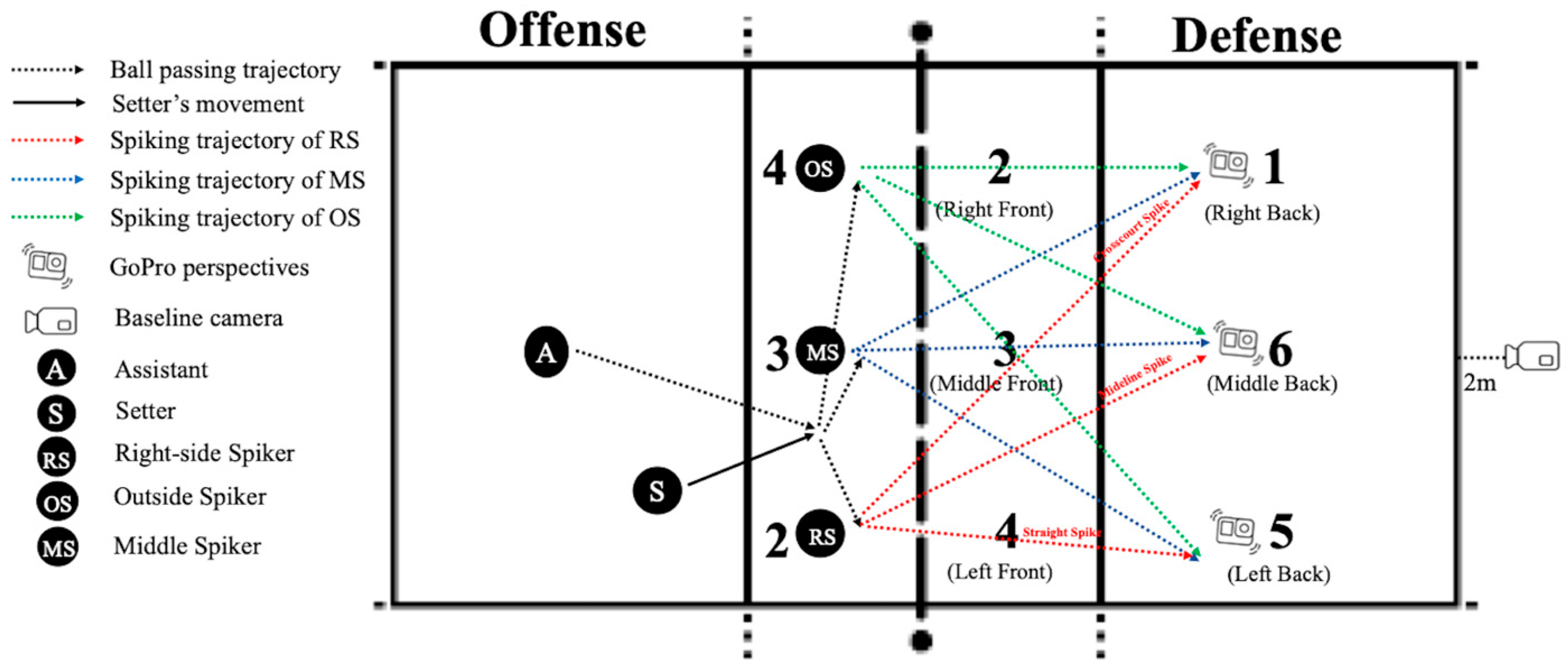

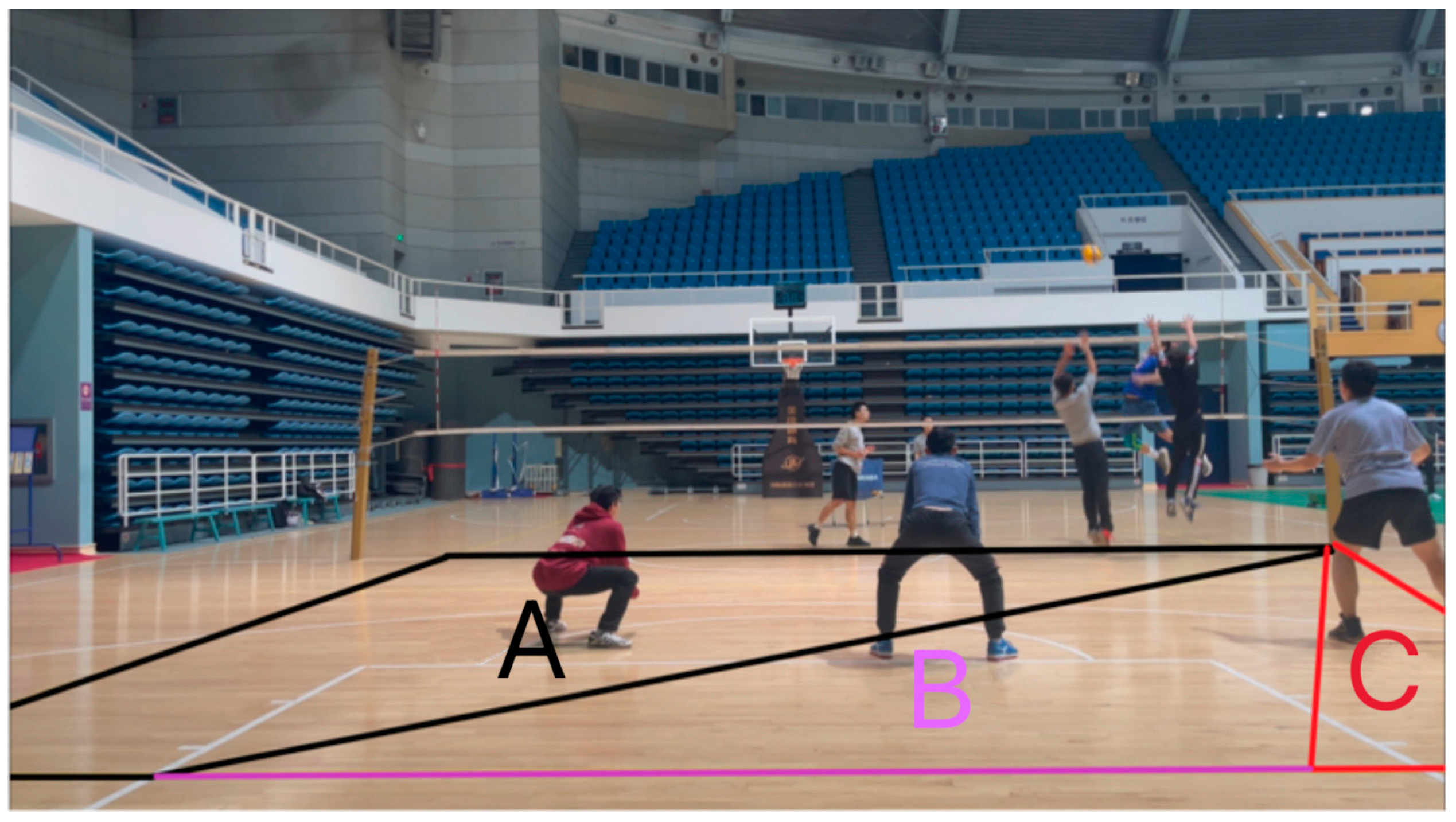
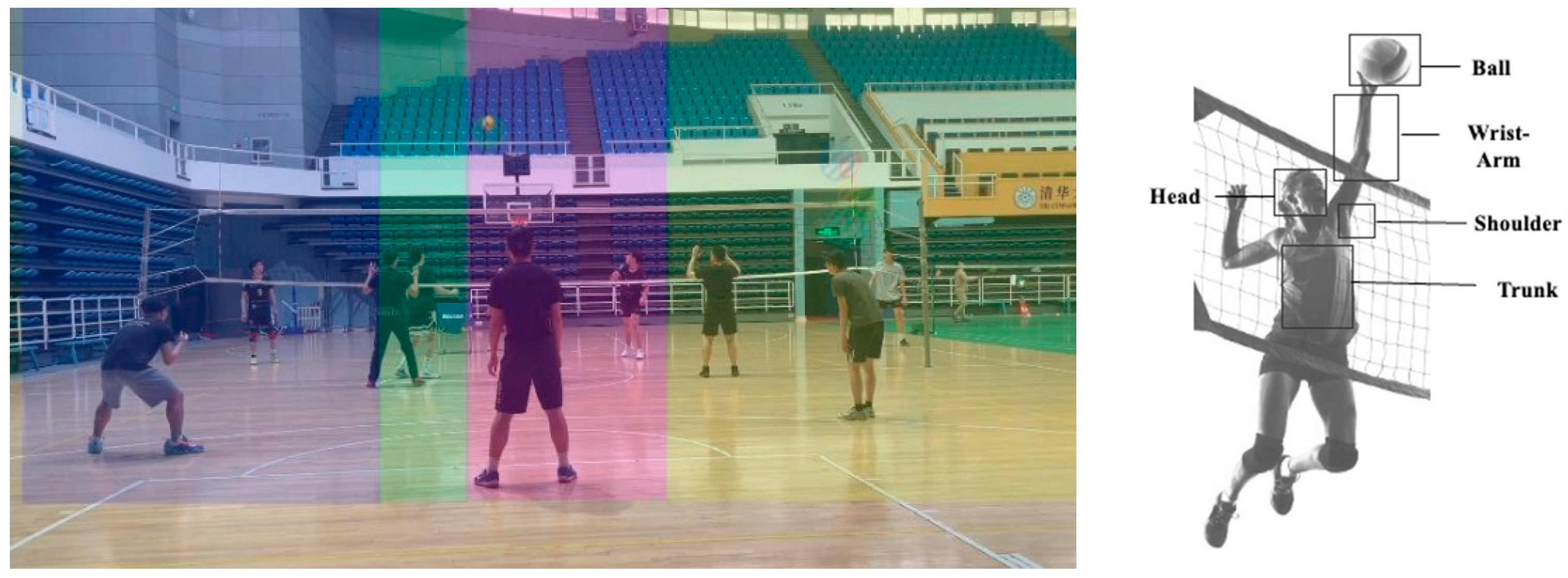
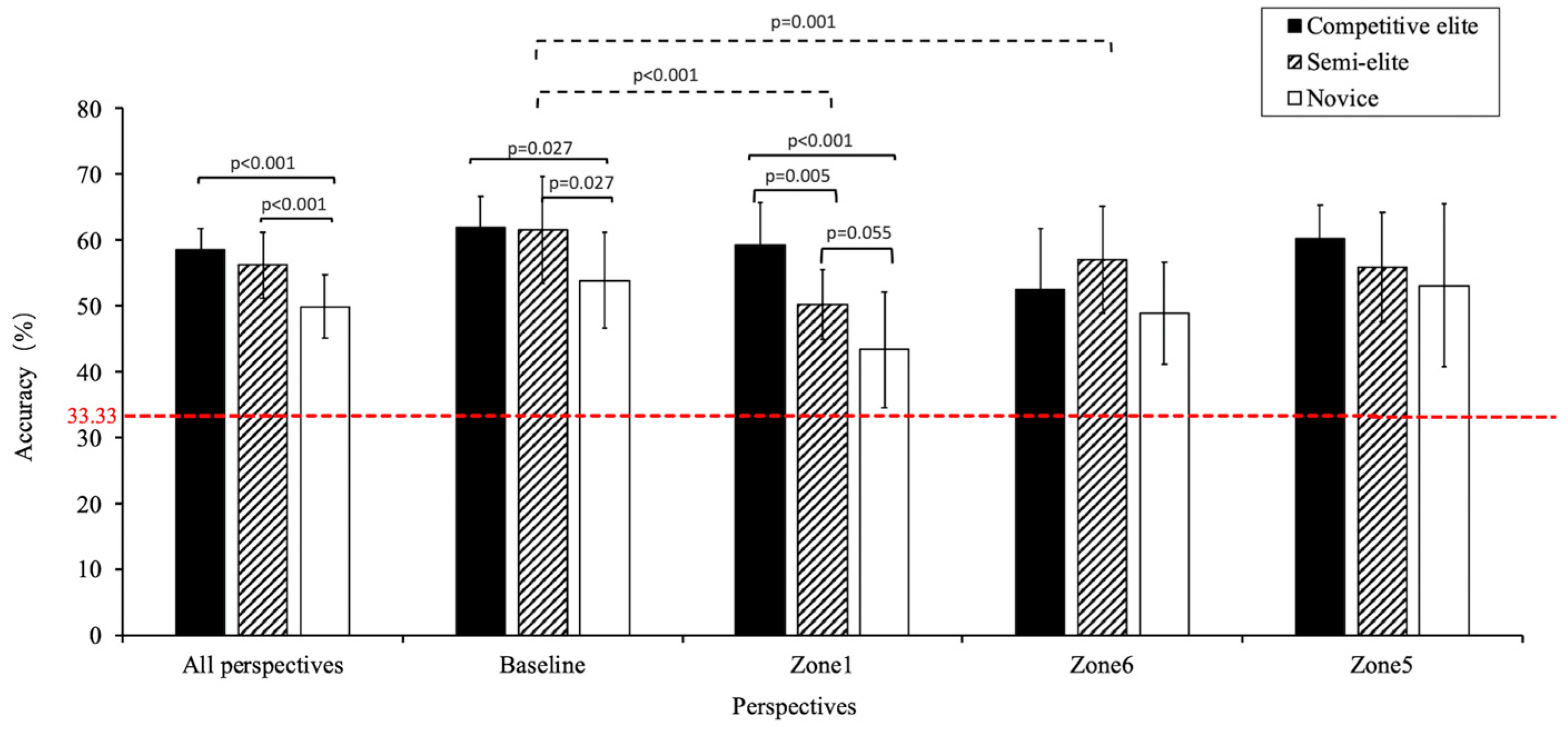
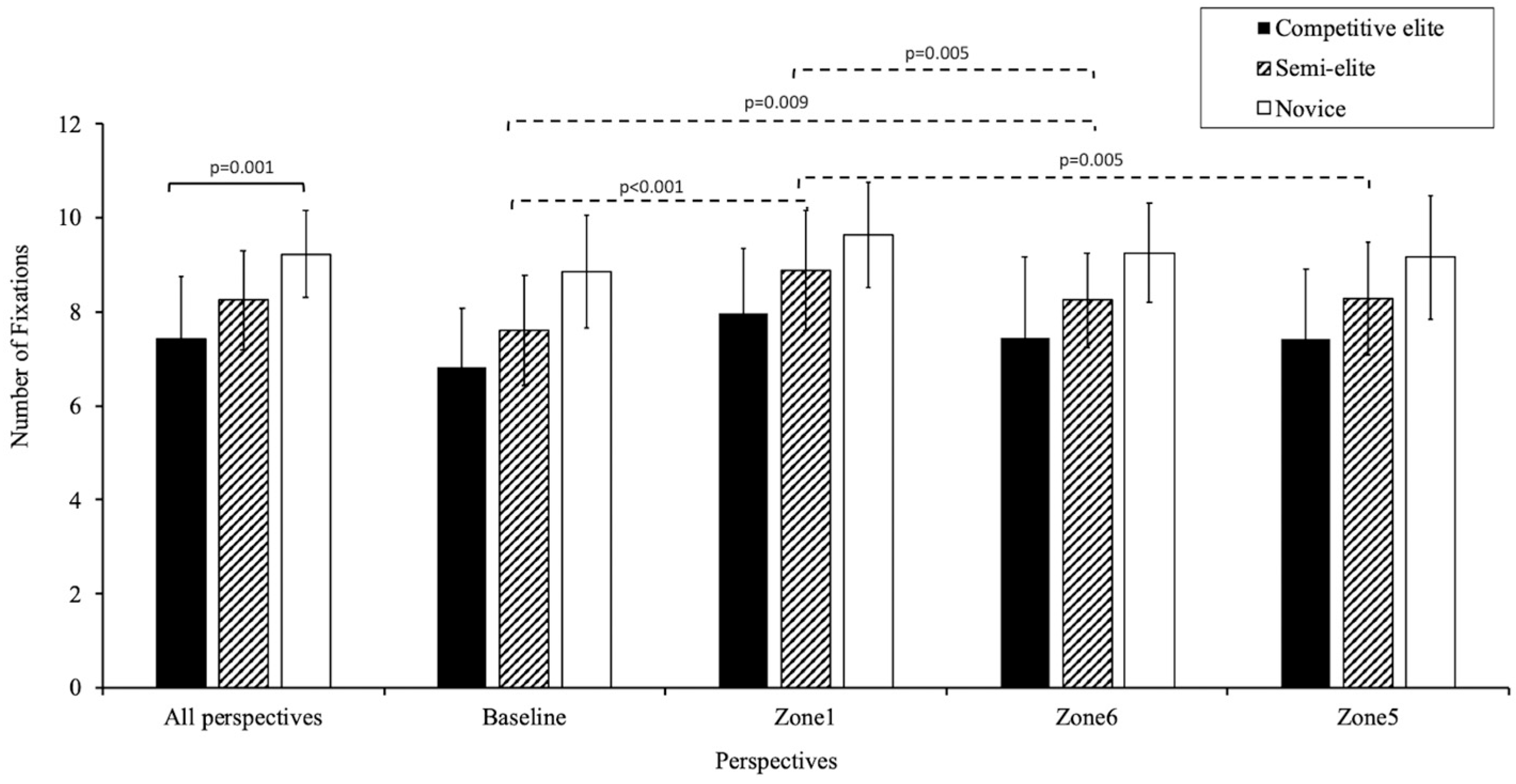
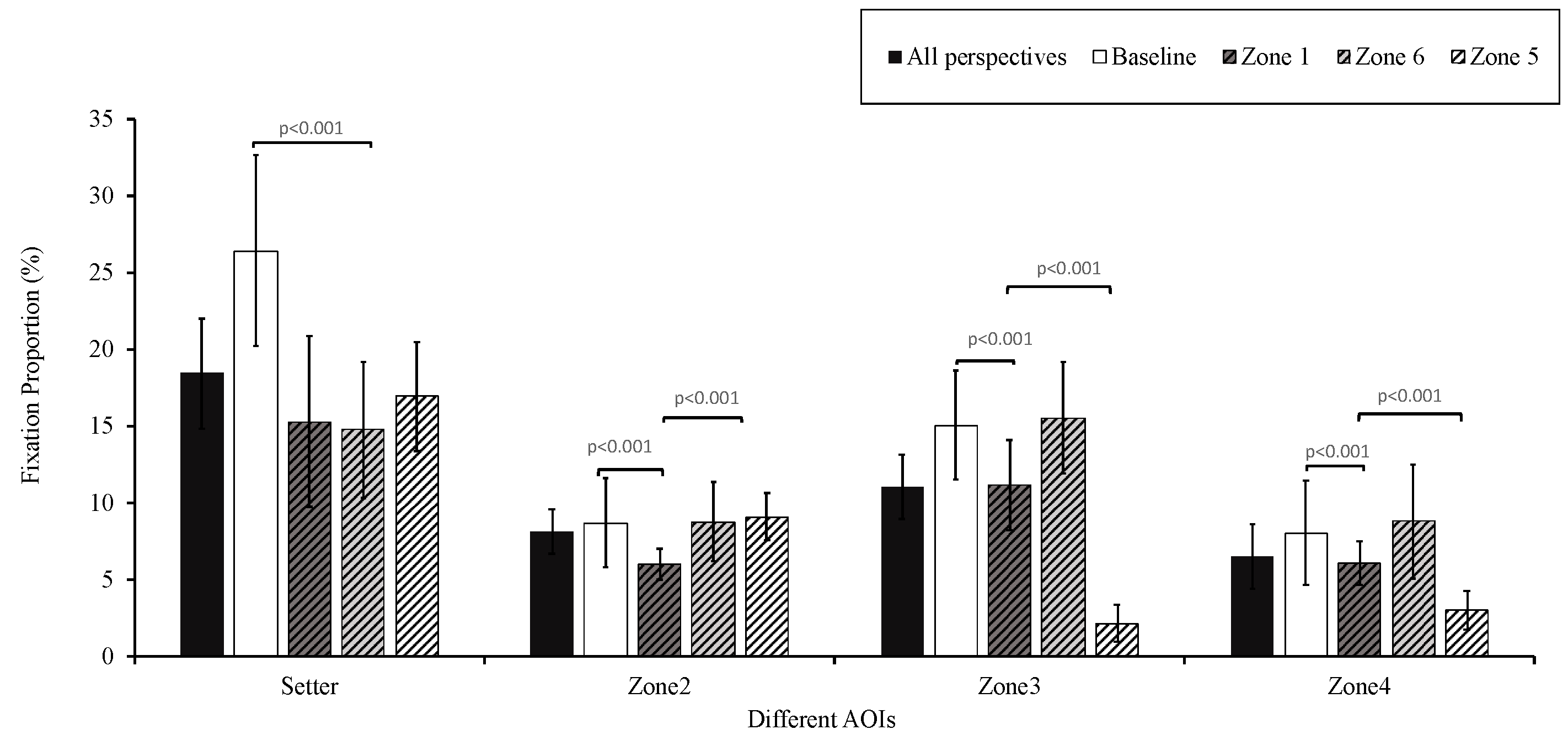
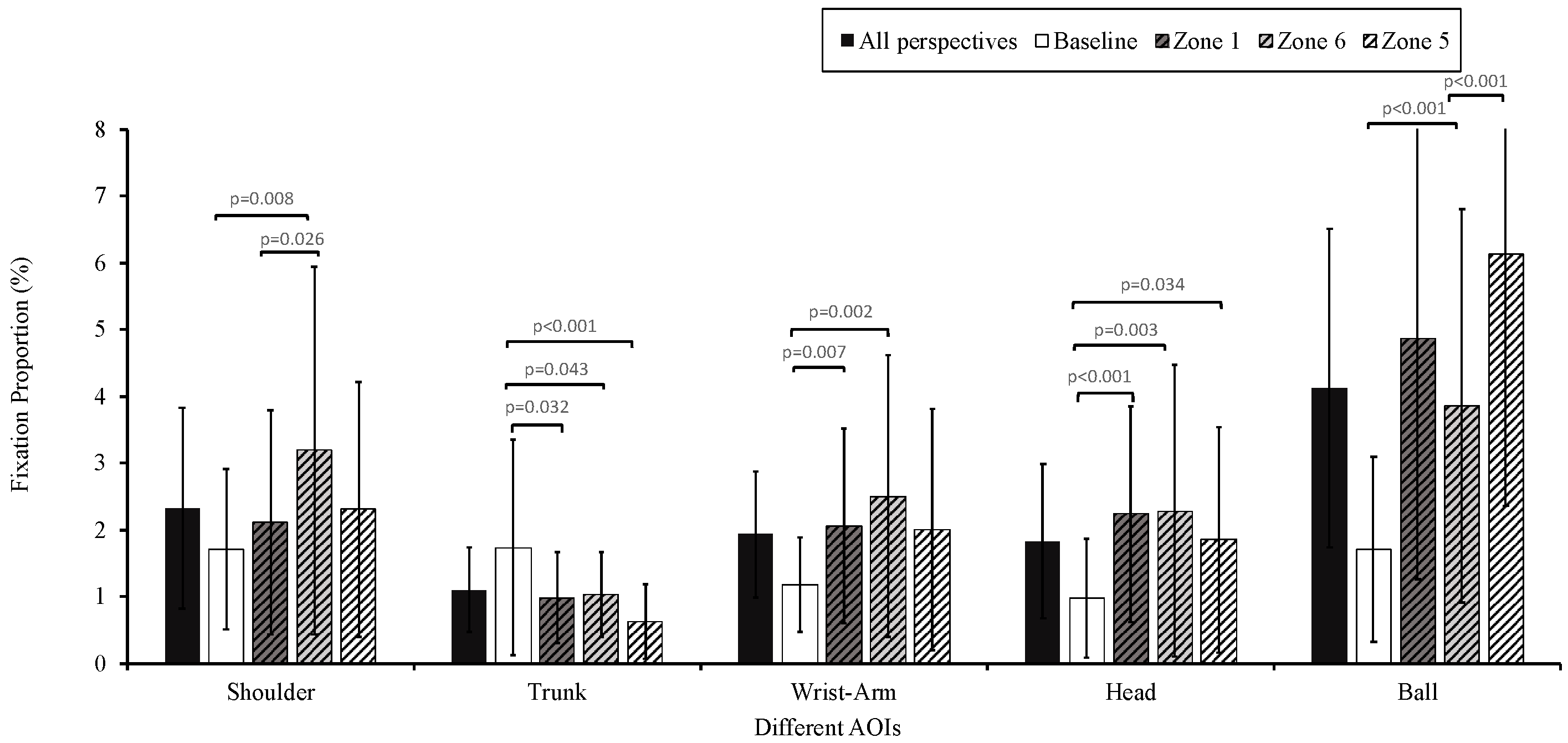
| Spiker + Spike Type | Baseline | Zone 1 | Zone 6 | Zone 5 | Total |
|---|---|---|---|---|---|
| Zone 2 (RS) + Crosscourt | 5 | 5 | 5 | 5 | 20 |
| Zone 2 (RS) + Midline | 2 | 2 | 2 | 2 | 8 |
| Zone 2 (RS) + Straight | 4 | 4 | 4 | 4 | 16 |
| Zone 3 (MS) + Crosscourt | 1 | 1 | 1 | 1 | 4 |
| Zone 3 (MS) + Midline | 4 | 4 | 4 | 4 | 16 |
| Zone 4 (OS) + Crosscourt | 2 | 2 | 2 | 2 | 8 |
| Zone 4 (OS) + Midline | 5 | 5 | 5 | 5 | 20 |
| Zone 4 (OS) + Straight | 3 | 3 | 3 | 3 | 12 |
| Total | 26 | 26 | 26 | 26 | 104 |
Disclaimer/Publisher’s Note: The statements, opinions and data contained in all publications are solely those of the individual author(s) and contributor(s) and not of MDPI and/or the editor(s). MDPI and/or the editor(s) disclaim responsibility for any injury to people or property resulting from any ideas, methods, instructions or products referred to in the content. |
© 2024 by the authors. Licensee MDPI, Basel, Switzerland. This article is an open access article distributed under the terms and conditions of the Creative Commons Attribution (CC BY) license (https://creativecommons.org/licenses/by/4.0/).
Share and Cite
Zhu, R.; Zou, D.; Wang, K.; Cao, C. Expert Performance in Action Anticipation: Visual Search Behavior in Volleyball Spiking Defense from Different Viewing Perspectives. Behav. Sci. 2024, 14, 163. https://doi.org/10.3390/bs14030163
Zhu R, Zou D, Wang K, Cao C. Expert Performance in Action Anticipation: Visual Search Behavior in Volleyball Spiking Defense from Different Viewing Perspectives. Behavioral Sciences. 2024; 14(3):163. https://doi.org/10.3390/bs14030163
Chicago/Turabian StyleZhu, Ruihan, Deze Zou, Keji Wang, and Chunmei Cao. 2024. "Expert Performance in Action Anticipation: Visual Search Behavior in Volleyball Spiking Defense from Different Viewing Perspectives" Behavioral Sciences 14, no. 3: 163. https://doi.org/10.3390/bs14030163
APA StyleZhu, R., Zou, D., Wang, K., & Cao, C. (2024). Expert Performance in Action Anticipation: Visual Search Behavior in Volleyball Spiking Defense from Different Viewing Perspectives. Behavioral Sciences, 14(3), 163. https://doi.org/10.3390/bs14030163







